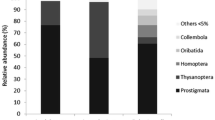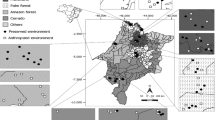Abstract
Eutetranychus orientalis has become an important pest of the ornamental tree Melia azedarach in the city of Seville (Spain). Trees suffer total defoliation at the end of summer. Studies were conducted in a regular plantation of this tree in the Miraflores Park in 2008 and 2009, to determine the arthropod faunal composition, with particular interest in the possible natural enemies of E. orientalis. Eutetranychus orientalis accounted for 98.3% of the arthropods found on the leaflets. Two species of phytoseiids were found, Euseius scutalis and Euseius stipulatus, but they only represented 0.2% of the arthropods. The most abundant insect was the predator thrips Scolothrips longicornis, which accounted for 0.9% of the arthropods found. The population of E. orientalis reached two peaks in 2008, with 325 individuals per leaflet in August, and 100 individuals per leaflet in November. Scolothrips longicornis densities closely followed E. orientalis, and predation was observed on various mite instars. Phytoseiids did not show such a response to the E. orientalis densities. Eutetranychus orientalis was more abundant in the exterior part of the plantation. No differences of arthropod densities were found between the various orientations in the plantation (north vs. south, east vs. west), although E. orientalis densities were different between rows. Distribution of E. orientalis population was highly aggregative, that of S. longicornis population was less aggregative, whereas the phytoseiid population showed a random distribution.


Similar content being viewed by others
References
Ali FS, Zaher MA (2007) Effect of food and temperature on the biology of Typhlodrompis swirskii (Athias-Henriot) (Acari: Phytoseiidae). Acarines 1:17–21
Allaby M (ed) (2006) Dictionary of plant sciences. Oxford University Press, Oxford
Al-Shammery KA (2010) Different biological aspects of the predaceous mite Euseius scutalis (Acari: Gamasida: Phytoseiidae) and the effects due to feeding on three tetranychid mite species in Hail, Saudi Arabia. Asian J Biol Sci 3:77–84
Arneodo JD, Marini DC, Galdeano E, Meneguzzi N, Bacci M, Domecq C, Nome SF, Conci LR (2007) Diversity and geographical distribution of phytoplasmas infecting China-tree in Argentina. J Phytopathol 155:70–75
Calvo FJ, Bolckmans K, Belda JE (2009) Development of a biological control-based integrated pest management method for Bemisia tabaci for protected sweet pepper crops. Entomol Exp Appl 133:9–18
Charleston DS, Kfir R, Dicke M, Vet LEM (2006) Impact of botanical extracts derived from Melia azedarach and Azadirachta indica on populations of Plutella xylostella and its natural enemies: a field test of laboratory findings. Biol Control 39:105–114
Cross JV (1984) Biological control of two-spotted spider mite (Tetranychus urticae) by Phytoseiulus persimilis on strawberries grown in ‘walk in’ plastic tunnels, and a simplified method of spider mite population assessment. Plant Pathol 33:417–423
El-Hady MM (2004) Susceptibility of the citrus brown mite, Eutetranychus orientalis (Klein) to the entomopathogenic fungi Verticillium lecanii and Metahrrizium anisopliae. Egypt J Biol Pest Control 14:409–410
El-Sawi SA (2008) Toxicity and bioactivity of Melia azedarach L. on the two spotted spider mite Tetranychus urticae Koch (Acari: Tetranychidae), and its predacious mite, Euseius scutalis (Athais—Henriot) (Acari: Phytoseiidae). Egypt J Biol Pest Control 18:289–295
EPPO (2010) Data sheets on quarantine pests: Eutetranychus orientalis. http://www.eppo.org/QUARANTINE/insects/Eutetranychus_orientalis/EUTEOR_ds.pdf. Accessed 2 August 2010
Ferragut F, Escudero A (1997) Taxonomía y distribución de los ácaros depredadores del género Euseius Wainstein 1962, en España (Acari: Phytoseiidae). Bol Sanid Veg Plagas 23:227–235
Ferragut F, Santonja MC (1989) Taxonomía y distribución de los ácaros del género Tetranychus Dufour 1832 (Acari: Tetranychidae), en España. Bol Sanid Veg Plagas 15:271–281
Fouly AH (1997) Effects of prey mites and pollen on the biology and life tables of Proprioseiopsis asetus (Chant) (Acari, Phytoseiidae). J Appl Entomol 121:435–439
García E, Márquez AL, Orta S, Alvarado P (2003) Caracterización de la presencia de Eutetranychus banksi (McGregor) y Eutetranychus orientalis (Klein) en el Sur de España. Phytoma España 153:90–96
García-Marí F, González-Zamora JE (1999) Biological control of Tetranychus urticae (Acari: Tetranychidae) with naturally occurring predators in strawberry plantings in Valencia, Spain. Exp Appl Acarol 23:487–495
García-Marí F, González-Zamora JE, Orenga Royo S, Saques Fernandez J, Laborda Cenjor R, Soto Sanchez A, Ribes Koninckx A (1991) Distribución espacial y asociación entre especies de ácaros fitófagos (Tetranychidae) y depredadores (Phytoseiidae) en hojas de fresón. Bol Sanid Veg Plagas 17:401–415
Gerlach S, Sengonça C (1985) Comparative studies on the efectiveness of the predatory mite, Phytoseiulus persimilis Athias-Henriot, and the predatory thrips, Scolothrips longicornis Priesner. J Plant Dis Prot 92:138–146
Hammad EAF, McAuslane HJ (2006) Effect of Melia azedarach L. extract on Bemisia argentifolii (Hemiptera: Aleyrodidae) and its biocontrol agent Eretmocerus rui (Hymenoptera: Aphelinidae). Environ Entomol 35:740–745
Ibrahim GA, El-Sayed El-Ghobashy KM, Shoeib AA (2005) Biological control of citrus brown mite Eutetranychus orientals using predatory mite, Neoseiulus californicus (McGregor) (Acari: Tetranychidae and Phytoseiidae) on citrus trees. Egypt J Agric Res 83:131–139
Imani Z, Shishehbor P (2009) Effect of temperature on life history and life tables of Eutetranychus orientalis (Klein) (Acari: Tetranychidae). Syst Appl Acarol 14:11–18
Jeppson LR, Keifer HH, Baker EL (1975) Mites injurious to economic plants. University of California Press, Berkeley
Jones VP (1990a) Developing sampling plans for spider mites (Acari: Tetranychidae): those who don’t remenber the past may have to repeat it. J Econ Entomol 83:1656–1664
Jones VP (1990b) Sampling and dispersion of the twospotted spider mite (Acari: Tetranychidae) and the western orchard predatory mite (Acari: Phytoseiidae) on tart cherry. J Econ Entomol 83:1376–1380
KapurGhai J, Mandeep K (2003) Differential susceptibility of various cultivars to infestation with the citrus brown mite, Eutetranychus orientalis. Annals Agri Bio Res 8:247–253
Márquez AL, Wong E, Garcia E, Olivero J (2006) Efficacy assay of different phytosanitary chemicals for the control of Eutetranychus orientalis (Klein) (oriental spider mite) on fine lemon and Valencia-Late orange crops. Bull OILB/SROP 29:305–310
McMurtry JA, Croft BA (1997) Life-styles of phytoseiid mites and their roles in biological control. Annu Rev Entomol 42:291–321
Migeon A, Dorkeld F (2009) Spider mites web: a comprehensive database for the tetranychidae. http://www.ensam.inra.fr/CBGP/spmweb/notespecies.php?id=321. Accessed 22 June 2010
Momen F, AbdelKhalek A (2008) Influence of diet on biology and life-table parameters of the predacious mite Euseius scutalis (A.H.) (Acari: Phytoseiidae). Arch Phytopathol Plant Prot 41:418–430
Momen F, El-Borolossy M (1999) Suitability of the citrus brown mite, Eutetranychus orientalis as prey for nine species of phytoseiid mites (Acari: Tetranychidae, Phytoseiidae). Acarologia 40:19–23
Mound LA, Morison GD, Pitkin BR, Palmer JM (1976) Thysanoptera. Royal Entomological Society of Lodon, London
Nathan SS, Savitha G, George DK, Narmadha A, Suganya L, Chung PG (2006) Efficacy of Melia azedarach L. extract on the malarial vector Anopheles stephensi Liston (Diptera: Culicidae). Bioresour Technol 97:1316–1323
Oatman ER, Badgley ME, Platner GR (1985) Predators of the two-spotted spider mite on strawberry. Cal Agric 1–2:9–12
Paz Z, Gerson U, Sztejnberg A (2007) Assaying three new fungi against citrus mites in the laboratory, and a field trial. Biocontrol 52:855–862
Rabindra P, Sanjay K, Devendra P (2006) An account of mite pest fauna associated with common vegetables grown in Ranchi. J Plant Prot Environ 3:149–151
Rasmy AH, Momen FM, Zaher AbouElella GM (2003) Influence of diet on life history and predatory capacity of Amblyseius zaheri Yousef & El-Brolossy (Acari: Phytoseiidae). Insect Sci Appl 23:31–34
Refaat AM, Momen FM, Amer SAA (2002) Acaricidal activity of sweet basil and French lavender essential oils against two species of mites of the family Tetranychidae (Acari: Tetranychidae). Acta Phytopathol Et Entomol Hung 37:287–298
Romeih AHM, Hassan MF, Rizk AboShnaf RIA (2005) Description and life history of Typhlodromus citri Hassan and Romeih sp. n. (Acari: Phytoseiidae). Egypt J Biol Pest Control 15:49–56
Song ZW, Xue XF, Hong XY (2006) Three new species of Aculops Keifer (Acari: Eriophyidae: Phyllocoptinae) from Gansu Province, China. Orient Insects 40:381–390
Song ZW, Xue XF, Hong XY (2008) Eriophyoid mite fauna (Acari: Eriophyoidea) of Gansu Province, northwestern China with descriptions of twelve new species. Zootaxa 1756: 1–48
SPSS Inc (2006) SPSS 15.0 for windows. Version 15.0.1.
Tanigoshi LK, Bahdousheh M, Babcock JM, Sawaqued R (1990) Euseius scutalis (Athias-Henriot) a predator of Eutetranychus orientalis (Klein) (Acari: Phytoseiidae, Tetranychidae) in Jordan: toxicity of some acaricides to E. orientalis. Arab J Plant Prot 8:114–120
Taylor LR (1961) Aggregation, variance and the mean. Nature 189:732–735
Walter DE, Halliday RB, Smith D (1995) The oriental red mite, Eutetranychus orientalis (Klein) (Acarina, Tetranychidae), in Australia. J Aust Entomol Soc 34:307–308
Wilson LT, Hoy MA, Zalom FG, Smilanick JM (1984) Sampling mites in almonds: I. Within-tree distribution and cumping pattern of mites with comments on predatory-prey interactions. Hilgardia 5:1–13
Yadav SK, Ashok S, Veer S (2003) Relative efficacy of some insecticides/acaricides for the management of mite, Eutetranychus orientalis (Klein), on ber under field conditions. Annal Biol 19:221–223
Zaher MA, El-Bishlawy SAO, Ali FS (2007) Some ecological and biological studies on Typhlodrompis swirskii (Athias-Henriot) (Acari: Phytoseiidae). Acarines 1:23–27
Zhou C, Zhang W, Qiao L, Sun X, Wang Z (2006) The biological characteristics, effective accumulate temperature and occurrence regulation of Eutetranychus orientalis. Sci Silvae Sinicae 42:89–93
Acknowledgements
The authors wish to thank Carmen Lora, director of the Miraflores Park of Seville city, for her support and for allowing us the use of the facilities in the park to carry out this work. We also thank Pedro Torrent, from the Servicio de Parques y Jardines of Seville town council, for his help in finding the sampling zones and throughout the period of study. Species of mites were determined and/or confirmed by Francisco Ferragut, from the Universidad Politécnica de Valencia (Spain).
Author information
Authors and Affiliations
Corresponding author
Rights and permissions
About this article
Cite this article
González-Zamora, J.E., López, C. & Avilla, C. Population studies of arthropods on Melia azedarach in Seville (Spain), with special reference to Eutetranychus orientalis (Acari: Tetranychidae) and its natural enemies. Exp Appl Acarol 55, 389–400 (2011). https://doi.org/10.1007/s10493-011-9476-y
Received:
Accepted:
Published:
Issue Date:
DOI: https://doi.org/10.1007/s10493-011-9476-y




